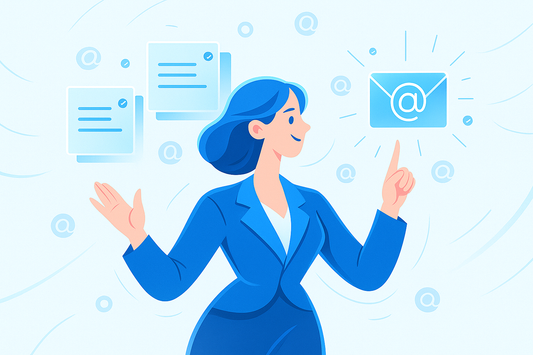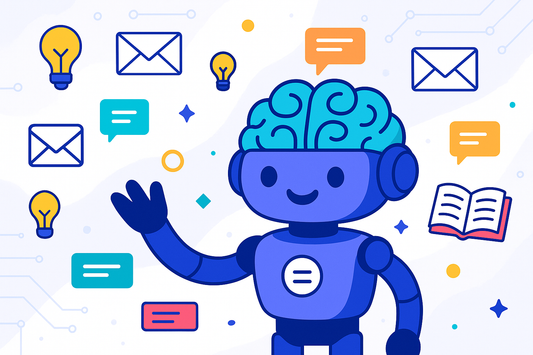Want to spend less time on emails? Gmail's built-in AI tools and add-ons can help you cut response times by up to 50% while staying professional and personal. Here's how:
- Use Gmail's AI Features: Tools like Smart Compose, Smart Reply, and Nudging speed up drafting and remind you about missed emails.
- Add Third-Party AI Tools: Apps like Ready to Send and Grammarly improve automation, personalization, and tone.
- Personalize Responses: AI can tailor emails based on past conversations, saving time while keeping communication relevant.
- Organize Your Inbox: Filters, labels, and scheduling email time help streamline your workflow.
- Balance Automation with Human Input: Review AI-generated emails to maintain quality and accuracy.
These steps combine automation with human oversight to save time without losing the personal touch. Use Gmail's features and third-party tools wisely to stay on top of your inbox!
Reduce Email Response Time by 90% with AI
1. Using Gmail's AI Features
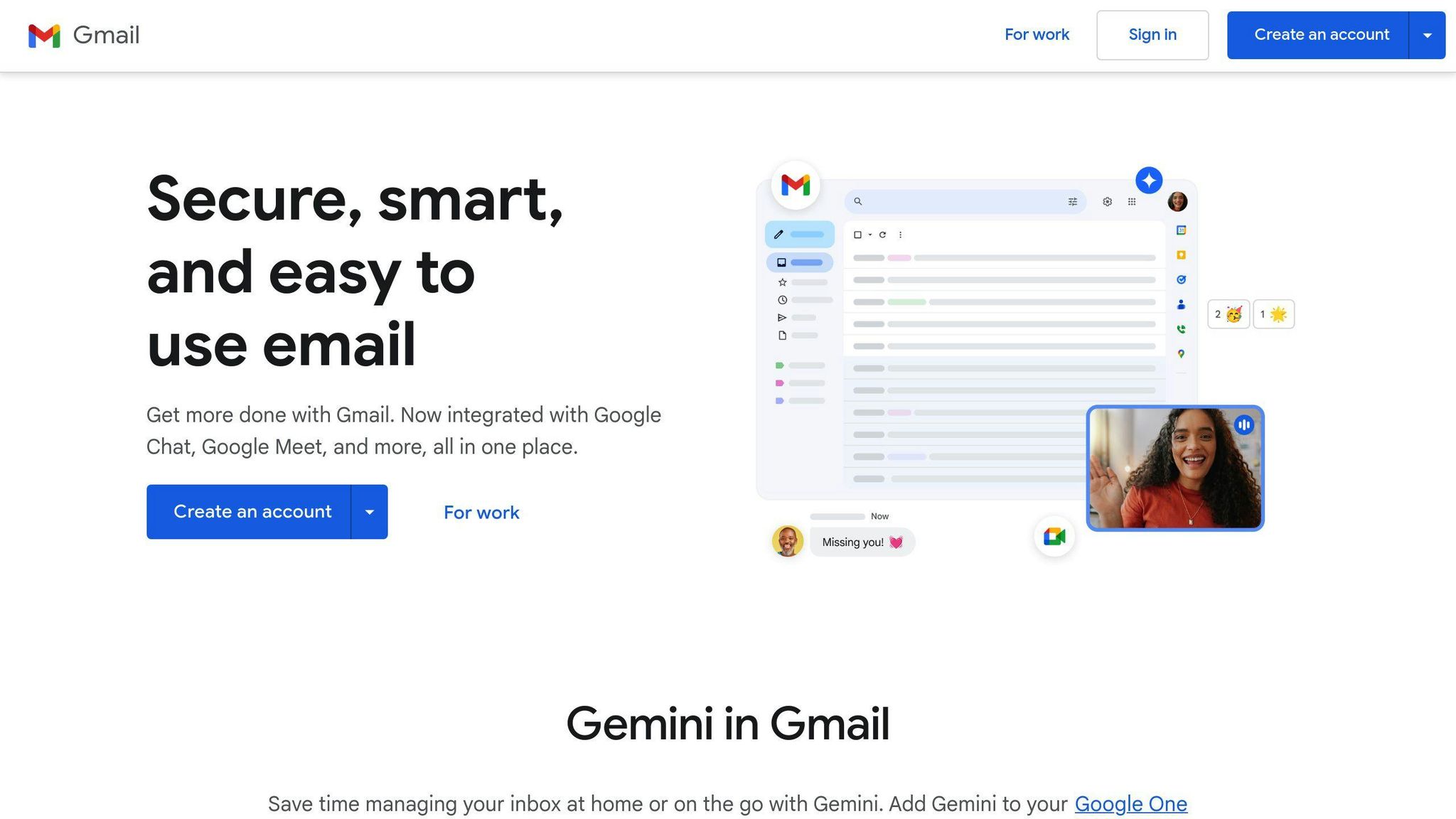
Gmail's AI tools simplify email management by automating repetitive tasks and helping you maintain a professional tone with less effort.
Smart Compose
Smart Compose predicts and suggests text as you type, making it easier to complete routine phrases like greetings or sign-offs. It also adapts to your writing style, allowing you to draft emails faster without sacrificing clarity or accuracy.
Smart Reply
Smart Reply provides quick, relevant responses to incoming emails. For instance, if someone asks about your availability, it might suggest, "Yes, I can attend." You can send these suggestions as-is or tweak them to add a personal touch, saving time while keeping your responses polished.
Nudging
Nudging highlights emails you may have missed by moving them to the top of your inbox. It acts as a reminder for unanswered messages, helping you stay on top of follow-ups. Over time, it learns your habits, making its reminders more aligned with your priorities. This ensures you maintain timely communication, which is essential in professional settings.
To get the most out of these tools:
- Turn on all AI features in Gmail settings.
- Review AI-generated suggestions to ensure they match your tone.
- Actively use Smart Compose for faster drafting.
- Keep an eye on Nudging reminders to avoid missing key emails.
If you need even more functionality, consider integrating third-party AI tools to take your email productivity up a notch.
2. Using Third-Party AI Tools
Gmail's built-in AI features are helpful, but third-party tools can take email management to the next level. These tools help handle more complex tasks, save time, and make your email responses even faster.
Ready to Send
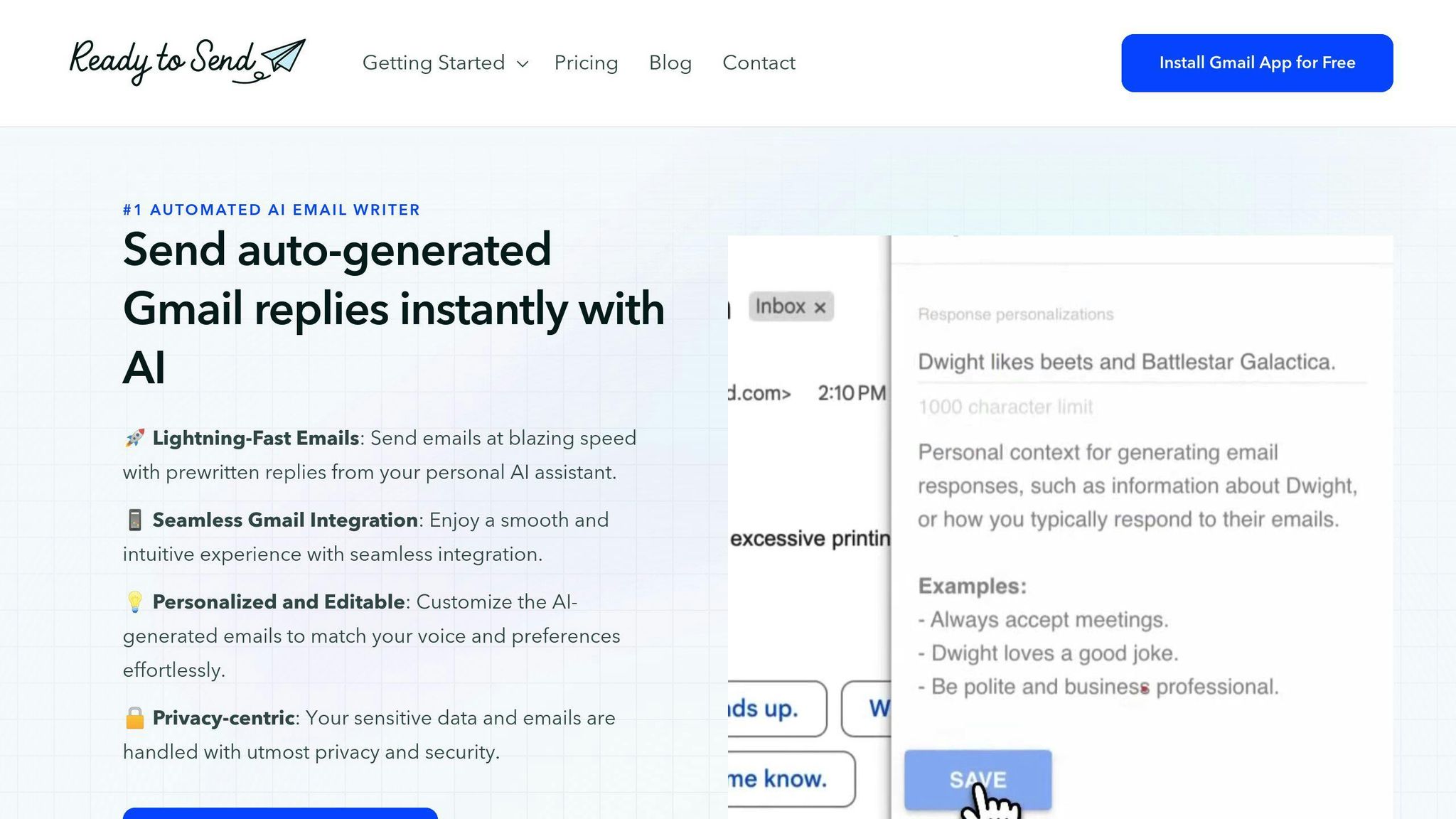
Ready to Send integrates directly with Gmail, offering advanced automation for your emails. It creates personalized drafts that match your writing style and adapts to specific contacts or situations. Supporting over 100 languages, it’s a great option for multilingual communication. Key features include:
- Customizable responses
- Mobile-friendly design
- Privacy-first data handling
Ready to Send also offers flexible pricing plans and a free trial for new users.
AI Mail Assistants
AI-powered email assistants like Edison Mail and Superhuman simplify email management by summarizing threads and drafting replies. They’re particularly useful for maintaining tone and intent when translating emails. These tools can:
- Summarize long or complex email chains
- Create drafts based on earlier conversations
- Automate responses to routine queries
- Highlight messages that need your personal attention
Grammarly's AI Email Writer
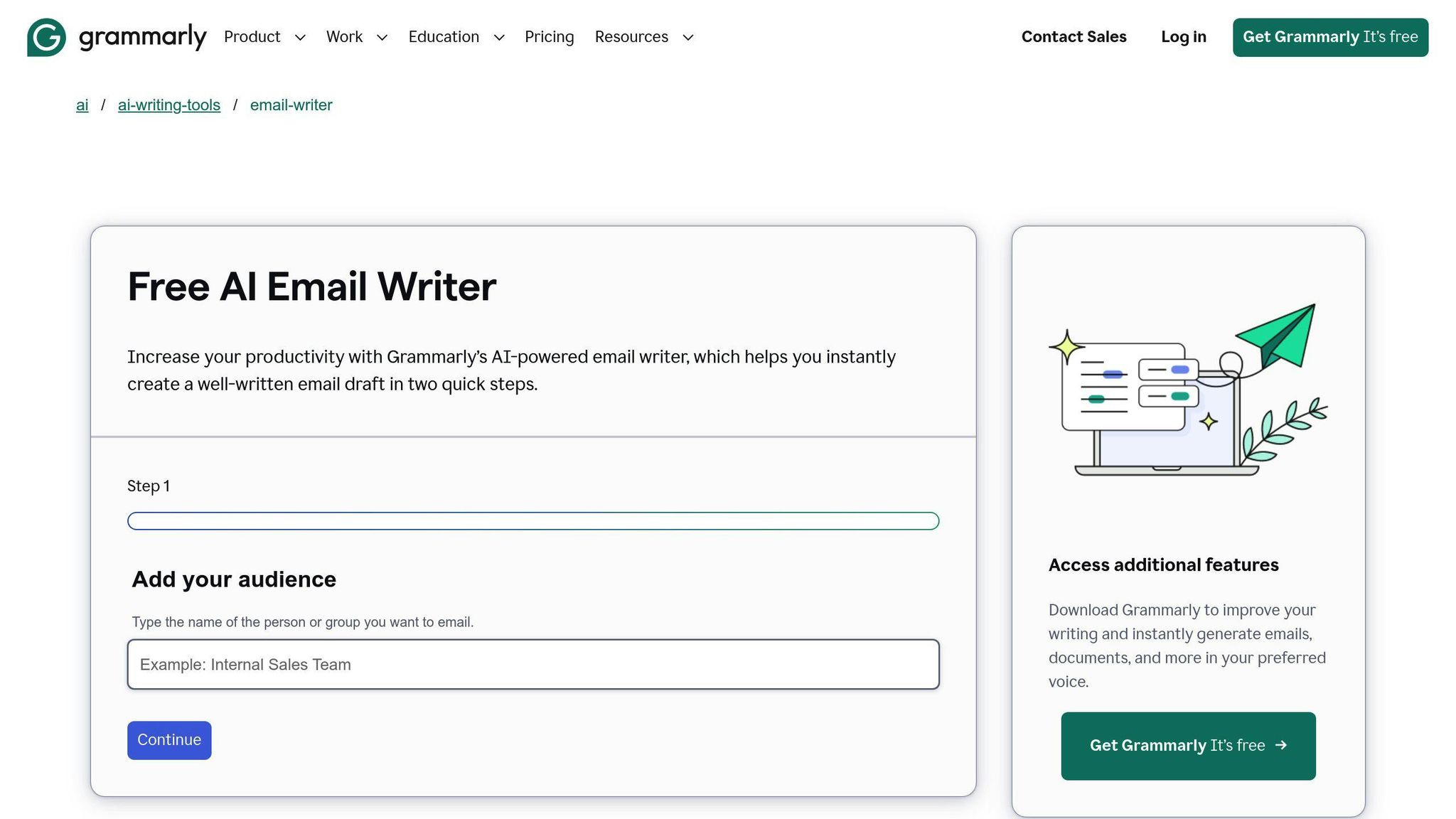
Grammarly goes beyond grammar checks by enhancing your emails with features like tone detection and context-specific suggestions. It helps ensure your emails are polished, professional, and suited to your audience.
When using third-party AI tools, always review their privacy policies, especially for sensitive information. Keep an eye on AI-generated replies to ensure they meet your standards and align with your communication style.
These tools not only save time but also improve the quality of your responses, which can strengthen client relationships and boost efficiency.
3. Personalizing Email Responses with AI
Tailoring Responses
Using personalized emails not only helps build stronger connections but also makes drafting emails faster by cutting down on repetitive edits. AI tools go beyond basic templates by pulling in details from earlier conversations.
To make the most of these tools, look for features that can:
- Analyze previous interactions with the recipient
- Pinpoint key points from past conversations
- Keep a consistent tone in all communications
- Automatically include relevant personal details
While AI can handle routine tasks, you should always review and tweak suggestions for important emails that require a more thoughtful touch.
Quick Personalization with AI
Tools like Ready to Send use machine learning to analyze your writing style and create drafts that sound like you. These tools can automatically add:
- References to the recipient and past exchanges
- Specific project details
- Custom signatures based on the recipient
| Personalization Method | Time Saved | Personalization Level | Best Use Case |
|---|---|---|---|
| Smart Reply | 70-80% | Basic | Quick replies |
| Smart Compose | 50-60% | Moderate | Standard business emails |
| AI Mail Assistant | 40-50% | High | Detailed customer interactions |
| Manual + AI Review | 30-40% | Very High | Important client communications |
To keep AI-generated emails polished and personal:
- Review Suggestions: Always double-check AI-generated drafts for tone and accuracy.
- Customize Training Data: Use your best emails to teach the AI how to replicate your style.
- Track Performance: Monitor metrics like response rates to improve personalization over time.
While AI can boost personalization, organizing your email process is just as important for cutting down response times.
sbb-itb-cd77960
4. Organizing Email Management
Using Filters and Labels
Gmail filters can automatically sort emails based on sender, subject, or keywords into labeled folders like 'Priority Clients' or 'Team Updates'. This system cuts down on manual sorting and makes it easier to locate important emails. In fact, using well-organized labels can cut email processing time by nearly 50%.
Automating Routine Tasks
Automation tools can take care of repetitive email tasks, saving you time and effort. Here are a few popular options:
| Tool | Function | Benefit |
|---|---|---|
| Boomerang | Schedules emails and sets reminders | Saves 40% on tracking tasks |
| Sanebox | Filters out unimportant emails | Reduces inbox clutter by 60% |
| Hubspot Templates | Provides pre-written responses | Speeds up replies by 30% |
For even more efficiency, link Gmail to project management tools using platforms like Zapier. This integration can automatically create tasks from emails and send notifications directly to your team, ensuring nothing slips through the cracks.
Scheduling Email Time
Set aside specific time slots for managing your inbox. For example, handle high-priority emails in the morning, general emails around midday, and follow-ups in the late afternoon. This approach keeps you focused and helps you respond promptly.
To stick to this schedule:
- Turn off email notifications during deep work sessions.
- Use Gmail's analytics to monitor your response times.
- Add dedicated email blocks to your Google Calendar.
"Time management expert Laura Vanderkam advises setting specific times for email checks to reduce distractions and boost productivity."
5. Balancing Automation and Human Input
Streamlining your workflow is essential, but finding the right balance between automation and human oversight ensures your emails stay accurate and maintain a personal touch.
Reviewing AI Responses
AI tools can speed up email replies, but they aren't perfect. Human review is key to catching potential errors or missteps. Here’s what to focus on when checking AI-generated content:
- Context Accuracy: Make sure the AI's response fits the situation. For example, if a client mentions delays in a project, the reply should address that directly rather than offering a vague acknowledgment.
- Tone Alignment: The tone should match the recipient’s expectations, especially for sensitive or high-stakes topics.
| Response Type | Review Priority | Key Check Points |
|---|---|---|
| Client Communications | High | Brand voice, commitment details, pricing accuracy |
| Internal Team Emails | Medium | Project specifics, deadline accuracy, resource allocation |
| Routine Updates | Low | Basic information accuracy, formatting consistency |
Customizing AI Tools
To get the most out of Gmail's AI features, tailor them to fit your communication style:
Smart Compose Tips
- Use Smart Compose consistently and tweak its suggestions to train it over time.
- Set language preferences if you often communicate in multiple languages.
Response Templates
- Build templates for frequently used scenarios, and include fields for personalization where needed.
- Check and update your AI settings every few months to ensure responses stay relevant and aligned with your current needs.
Wrapping It Up
Speeding up email replies in Gmail calls for a clever mix of AI-powered tools and human judgement. Tools like Ready to Send and Grammarly can help streamline your workflow by automating repetitive tasks and improving the quality of your messages. When used wisely, these tools allow professionals to stay efficient without losing the personal touch in their emails.
To make the most of these tools, focus on three main strategies:
- Leverage Gmail's Built-In AI Features: Turn on and tweak Gmail’s built-in tools to get quick productivity boosts.
- Add Personalization: Use context-aware communication to keep your messages engaging and relevant.
- Keep Human Oversight in Place: Ensure quality and professionalism by reviewing and refining automated responses.
The secret is striking the right balance. While AI can save time and effort, human oversight ensures your emails stay thoughtful and appropriate for the situation. Regularly reviewing and tailoring AI suggestions keeps your communication polished while reaping the benefits of faster response times.
FAQs
Can I use AI to reply to emails?
Yes, AI tools integrated with Gmail can make replying to emails quicker and easier. These tools are great for routine messages but still need human oversight for more sensitive or complicated situations.
Options like Smart Compose, Ready to Send, and Grammarly's AI Email Writer can help improve speed, add a personal touch, and maintain professionalism in your replies. Each one brings something different to the table, complementing Gmail's built-in features.
To get the most out of AI for email management:
- Adjust settings to reflect your communication style.
- Double-check AI-generated content for accuracy before hitting send.
- Handle sensitive or complex emails manually for better control.


